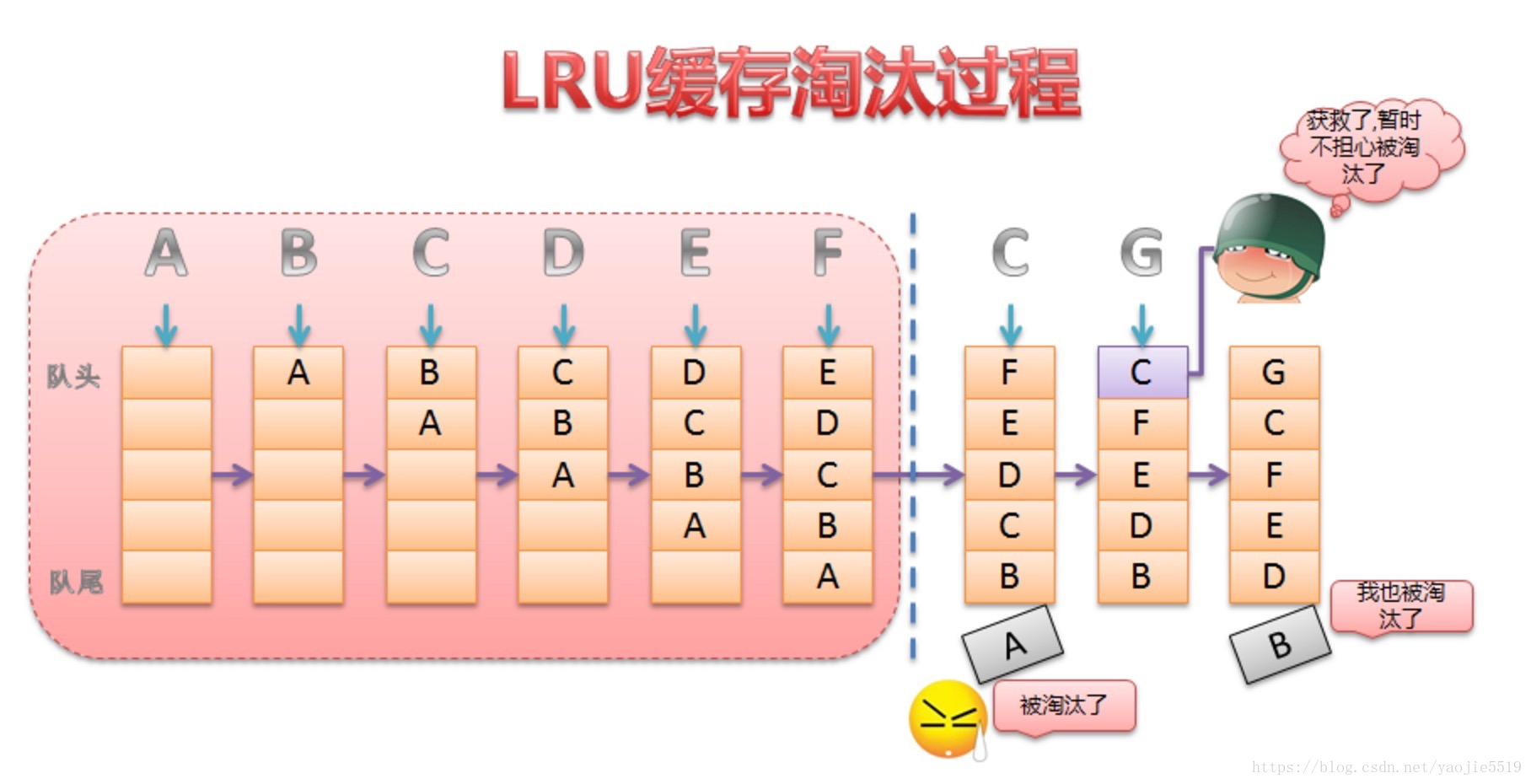一、LruCache简介
LruCache采用的缓存算法为LRU(Least Recently Used),即最近最少使用算法。核心思想是当缓存满时,会优先淘汰那些近期最少使用的缓存对象。其内部采用的数据结构是LinkedHashMap,当缓存满时,把最近最少使用的对象从内存中移除,并提供了get和put方法来完成缓存的获取和添加操作。
常用于图片缓存,但不局限与图片缓存。而且,LruCache是线程安全的,因此是可以采用多线程并发处理。
二、LruCache使用
LruCache的使用非常简单,以图片缓存为例。
创建LruCache:
//获取到应用的最大内存
int maxMemory = (int) (Runtime.getRuntime().maxMemory() / 1024);
//设置LruCache的缓存大小
int cacheSize = maxMemory / 8;
//重写sizeOf,并返回以kB为单位的缓存对象的大小
mMemoryCache = new LruCache<String, Bitmap>(cacheSize){
@Override
protected int sizeOf(String key, Bitmap value) {
return value.getRowBytes() * value.getHeight() / 1024;
}
};使用:
//获取到缓存对象
mMemoryCache.get(key);
//添加缓存对象
mMemoryCache.put(key,value);三、LruCache原理
借用网上一张很形象的照片:
LruCache的核心思想就是维护一个缓存对象列表。按照访问顺序进行排列,最近访问的对象将放在队头,一直没访问的对象,将放在队尾,淘汰时从队尾淘汰。
LruCache的构造函数:
public LruCache(int maxSize) {
if (maxSize <= 0) {
throw new IllegalArgumentException("maxSize <= 0");
}
this.maxSize = maxSize;
this.map = new LinkedHashMap<K, V>(0, 0.75f, true);
}LinkedHashMap最后一个参数设置为访问顺序。
在LinkedHashMap中
public LinkedHashMap(int initialCapacity,
float loadFactor,
boolean accessOrder) {
super(initialCapacity, loadFactor);
this.accessOrder = accessOrder;
}accessOrder 为true时为访问顺序,为false,则为插入顺序。
举个栗子:
public static final void main(String[] args) {
LinkedHashMap<Integer, Integer> map = new LinkedHashMap<>(0, 0.75f, true);
map.put(0, 0);
map.put(1, 1);
map.put(2, 2);
map.put(3, 3);
map.put(4, 4);
map.put(5, 5);
map.put(6, 6);
map.get(1);
map.get(2);
for (Map.Entry<Integer, Integer> entry : map.entrySet()) {
System.out.println(entry.getKey() + ":" + entry.getValue());
}
}为true时输出结果是:
0:0
3:3
4:4
5:5
6:6
1:1
2:2为false时结果是:
0:0
1:1
2:2
3:3
4:4
5:5
6:6put()方法:
public final V put(K key, V value) {
//不可为空,否则抛出异常
if (key == null || value == null) {
throw new NullPointerException("key == null || value == null");
}
V previous;
synchronized (this) {
//插入的缓存对象值加1
putCount++;
//增加已有缓存的大小
size += safeSizeOf(key, value);
//向map中加入缓存对象
previous = map.put(key, value);
//如果已有缓存对象,则缓存大小恢复到之前
if (previous != null) {
size -= safeSizeOf(key, previous);
}
}
//entryRemoved()是个空方法,可以自行实现
if (previous != null) {
entryRemoved(false, key, previous, value);
}
//调整缓存大小(关键方法)
trimToSize(maxSize);
return previous;
}这里面没什么难点,需要注意一下trimToSize()方法。判断缓存是否已满,如果满了就会不断地删除LinkedHashMap中队尾的元素,即近期最少访问的,直到缓存大小小于最大值。
public void trimToSize(int maxSize) {
//死循环
while (true) {
K key;
V value;
synchronized (this) {
//如果map为空并且缓存size不等于0或者缓存size小于0,抛出异常
if (size < 0 || (map.isEmpty() && size != 0)) {
throw new IllegalStateException(getClass().getName()
+ ".sizeOf() is reporting inconsistent results!");
}
//如果缓存大小size小于最大缓存,或者map为空,不需要再删除缓存对象,跳出循环
if (size <= maxSize || map.isEmpty()) {
break;
}
//迭代器获取第一个对象,即队尾的元素,近期最少访问的元素
Map.Entry<K, V> toEvict = map.entrySet().iterator().next();
key = toEvict.getKey();
value = toEvict.getValue();
//删除该对象,并更新缓存大小
map.remove(key);
size -= safeSizeOf(key, value);
evictionCount++;
}
entryRemoved(true, key, value, null);
}
}get()方法:
public final V get(K key) {
//key为空抛出异常
if (key == null) {
throw new NullPointerException("key == null");
}
V mapValue;
synchronized (this) {
//获取对应的缓存对象
//get()方法会实现将访问的元素更新到队列头部的功能
mapValue = map.get(key);
if (mapValue != null) {
hitCount++;
return mapValue;
}
missCount++;
}get()方法获取集合中的缓存对象时,就代表访问了一次该元素,将会更新队列,保持整个队列是按照访问顺序排序。这个更新过程就是在LinkedHashMap中的get()方法中完成的。
public V get(Object key) {
LinkedHashMapEntry<K,V> e = (LinkedHashMapEntry<K,V>)getEntry(key);
if (e == null)
return null;
//实现排序的关键方法
e.recordAccess(this);
return e.value;
}void recordAccess(HashMap<K,V> m) {
LinkedHashMap<K,V> lm = (LinkedHashMap<K,V>)m;
//判断是否是访问排序
if (lm.accessOrder) {
lm.modCount++;
//删除此元素
remove();
//将此元素移动到队列的头部
addBefore(lm.header);
}
}
